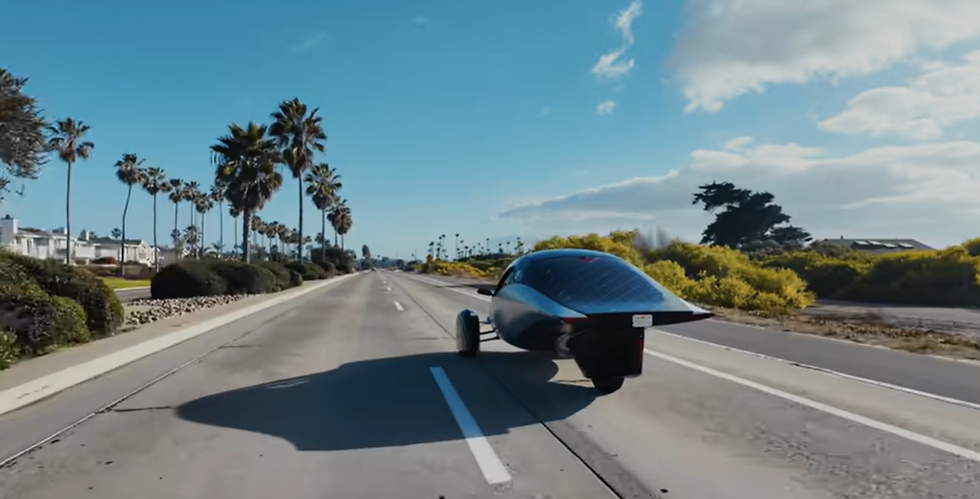Aptera Achieves Breakthrough Milestones in Solar Car Development with First Production-Intent Validation Vehicle
- Natalia Sousa
- Mar 7
- 3 min read
Aptera is making significant progress in solar car development, recently completing its first production-intent validation vehicle. Rigorous testing in the Mojave Desert has been key to verifying the vehicle's energy efficiency. This reinforces Aptera's commitment to changing the New Energy Vehicle (NEV) sector.
Coastdown Testing: A Measure of Efficiency
One of the standout tests conducted on Aptera's solar EV was coastdown testing. This process measured the vehicle’s efficiency, particularly its aerodynamic performance, rolling resistance, and powertrain losses. Notably, the solar EV took over three minutes to slow from 60 miles per hour to a complete stop while traveling uphill.
According to Aptera, this coastdown distance is longer than that of any vehicle currently on the market, whether gas or electric. For instance, traditional electric vehicles tend to take less time to decelerate, making Aptera's performance a remarkable achievement. This efficiency demonstrates the practical benefits of Aptera’s unique designs and the potential advantages of solar cars.

Aerodynamic Tuft Testing: Confirming Real-World Airflow on Solar Car
Beyond coastdown testing, Aptera carried out aerodynamic tuft testing. This involved applying small markers, known as tufts, on critical parts of the vehicle, including the wheel fairings and various gaps. This testing is essential as it helps verify that real-world airflow aligns well with Aptera's computer simulations.
The results from the tuft testing led to necessary adjustments in the vehicle's design. For example, adjustments to gaps between panels can significantly enhance aerodynamics. With these refinements, the vehicle’s overall efficiency is expected to improve further, ensuring that every detail of the design works towards higher performance.
“Our validation testing confirms that we’re on track to achieve our target energy consumption of roughly 100Wh/mile – unlocking a level of efficiency that makes solar mobility possible in a way never seen before. What started as Matlab calculations is now coming to life on the road. This is the future of transportation,” said Steve Fambro, co-founder and co-CEO of Aptera.
Extended Highway Drive Cycle: Real-World Efficiency Verification
Following aerodynamic tests, Aptera conducted an extensive highway drive cycle. This evaluation covered hundreds of miles while monitoring the solar EV’s energy consumption carefully. The results showed that Aptera's mathematical simulation model accurately predicted the vehicle's real-world efficiency, with only a few percent deviation.
To put this into perspective, traditional vehicles often experience larger discrepancies between predicted and actual fuel consumption, sometimes as much as 10% to 15%. This accuracy serves as strong validation of the vehicle's aerodynamics, drivetrain, and overall design, bolstering Aptera’s status in the solar car market. Such reliability is essential for fostering consumer trust in solar-powered options.
Continuous Improvement: The Next Validation Vehicle
Aptera is not stopping here; the company is already working on its next validation vehicle. This model aims to improve features such as tighter panel gaps and an optimized design for weight. These enhancements underscore Aptera's commitment to ongoing refinement, ensuring that each new version is better than the last.
Once the second validation vehicle is finished, it will undergo a rigorous testing cycle. This will include a range test, taking the vehicle from a fully charged battery to 0%. Engineers will also evaluate real-world solar charging performance to confirm daily solar range estimates. Being able to fully charge using sunlight is crucial for solar vehicles, as it directly impacts usability.
A Bright Future Ahead
Aptera's successful validation of its first production-intent solar vehicle marks an important milestone for both the company and the solar car industry. Through exhaustive testing and innovative designs, Aptera is not just refining its products but also shaping the future of transportation.
As the market for New Energy Vehicles expands, the advancements showcased by Aptera serve as motivation for consumers and manufacturers. By demonstrating that solar-powered vehicles can achieve remarkable efficiency, Aptera is establishing a foundation for a future where sustainable transportation options are widely accessible.


Comments